Estimation of Equivalent Number of Looks in Time-Series Pol(In)SAR Data
Abstract
:1. Introduction
2. Multi-dimension SAR Statistics and ENL Estimation
2.1. PolSAR Coherency Matrix Generation
2.2. Multi-dimension SAR Coherency Matrix Statistics
2.3. TM Estimator of ENL
3. Novel ENL Estimators for TSPol(In)SAR Data
3.1. PolInSAR Data Statistics and TM-PolInSAR Estimator
3.2. Standard TSPolInSAR Data Statistics and TM-TSPolInSAR Estimator
3.3. TSPolSAR Data Statistics and STM-TSPolSAR Estimator
3.4. Single Reference TSPolInSAR Statistics and STM-TSPolInSAR Estimator
3.5. ENL Estimation Procedure Based on The Selected Estimator
- (1)
- Based on the acquired scattering vector stack with N SAR observation, construct the TSPolSAR data and the corresponding TSPol(In)SAR data according to the practical application.
- (2)
- Perform a temporal average of time-series polarimetric coherency matrices, and create the Pauli basis RGB (PauliRGB) image.
- (3)
- Select an appropriate estimator according to the TSPol(In)SAR data type and estimate the ENL of the full scene with a sliding window.
- (4)
- With the help of both PauliRGB and estimated ENL images, select a homogeneous area manually for the following ENL statistics.
- (5)
- Perform a kernel density estimator (KDE) implemented with the normal kernel function to estimate the mean and standard deviation (STD) for avoiding the unpredictable sharp and possible multimodality of the distribution.
4. Results and Analyses of Simulated TSPol(In)SAR data
4.1. Simulated TSPolInSAR Data Generation and Parameter Settings
4.2. Results and Analyses of Different ENL Estimators
5. Experimental Results of Two Real TSPol(In)SAR Datasets
5.1. Experimental Results Based on C-band RADARSAT-2 TSPolSAR Data
5.2. Experimental Results Based on P-band E-SAR TSPolInSAR Data
6. Discussion and Analysis Based on Two Real TSPol(In)SAR Datasets
6.1. Comparison of Statistical Characteristics Based on The Homogeneous Areas
6.2. Comparison of Homogeneity Evaluation Performance Based on the Textured Areas
6.3. Efficiency Comparison Based on Two TSPol(In)SAR Datasets
7. Conclusions
- (1)
- The TM-PolInSAR estimator can be applied to PolInSAR data;
- (2)
- The ENL of TSPolSAR data can be estimated by the STM-TSPolSAR estimator;
- (3)
- The STM-TSPolInSAR estimator can be applied to TSPolInSAR data with single reference or small baseline set.
- (4)
- In case of fewer observations, the proposed TM-TSPolInSAR estimator estimates the ENL of standard TSPolInSAR data.
Author Contributions
Funding
Acknowledgments
Conflicts of Interest
References
- Lee, J.S.; Pottier, E. Polarimetric Radar Imaging: From Basics to Applications; CRC Press: Boca Raton, Fl, USA, 2009. [Google Scholar]
- Vasile, G.; Trouve, E.; Lee, J.S.; Buzuloiu, V. Intensity-driven adaptive-neighborhood technique for polarimetric and interferometric SAR parameters estimation. IEEE Trans. Geosci. Remote Sens. 2006, 44, 1609–1621. [Google Scholar] [CrossRef] [Green Version]
- Lee, J.S.; Wen, J.H.; Ainsworth, T.L.; Chen, K.S.; Chen, A.J. Improved sigma filter for speckle filtering of SAR imagery. IEEE Trans. Geosci. Remote Sens. 2009, 47, 202–213. [Google Scholar]
- Lee, J.; Ainsworth, T.L.; Wang, Y.; Chen, K. Polarimetric SAR speckle filtering and the extended sigma filter. IEEE Trans. Geosci. Remote Sens. 2015, 53, 1150–1160. [Google Scholar] [CrossRef]
- Conradsen, K.; Nielsen, A.A.; Schou, J.; Skriver, H. A test statistic in the complex Wishart distribution and its application to change detection in polarimetric SAR data. IEEE Trans. Geosci. Remote Sens. 2003, 41, 4–19. [Google Scholar] [CrossRef] [Green Version]
- Liu, M.; Zhang, H.; Wang, C.; Wu, F. Change detection of multilook polarimetric SAR images using heterogeneous clutter models. IEEE Trans. Geosci. Remote Sens. 2014, 52, 7483–7494. [Google Scholar]
- Kersten, P.R.; Lee, J.S.; Ainsworth, T.L. Unsupervised classification of polarimetric synthetic aperture Radar images using fuzzy clustering and EM clustering. IEEE Trans. Geosci. Remote Sens. 2005, 43, 519–527. [Google Scholar] [CrossRef]
- Frery, A.C.; Correia, A.H.; Da Freitas, C.D. Classifying multifrequency fully polarimetric imagery with multiple sources of statistical evidence and contextual information. IEEE Trans. Geosci. Remote Sens. 2007, 45, 3098–3109. [Google Scholar] [CrossRef]
- Doulgeris, A.P.; Anfinsen, S.N.; Eltoft, T. Classification with a Non-Gaussian Model for PolSAR Data. IEEE Trans. Geosci. Remote Sens. 2008, 46, 2999–3009. [Google Scholar] [CrossRef] [Green Version]
- Jager, M.; Neumann, M.; Guillaso, S.; Reigber, A. A self-initializing PolinSAR classifier using interferometric phase differences. IEEE Trans. Geosci. Remote Sens. 2010, 45, 3503–3518. [Google Scholar] [CrossRef]
- Doulgeris, A.P. An automatic U-distribution and markov random field segmentation algorithm for PolSAR images. IEEE Trans. Geosci. Remote Sens. 2015, 53, 1819–1827. [Google Scholar] [CrossRef] [Green Version]
- Lopes, A.; Touzi, R.; Nezry, E. Adaptive speckle filters and scene heterogeneity. IEEE Trans. Geosci. Remote Sens. 1990, 28, 992–1000. [Google Scholar] [CrossRef]
- Lang, F.K.; Yang, J.; Li, D.R. Adaptive-Window polarimetric SAR image speckle filtering based on a homogeneity measurement. IEEE Trans. Geosci. Remote Sens. 2015, 53, 5435–5446. [Google Scholar] [CrossRef]
- Shen, P.; Wang, C.; Luo, X.; Fu, H.; Zhu, J. PolInSAR complex coherence nonlocal estimation using shape-adaptive patches matching and trace-moment-based NLRB estimator. IEEE Trans. Geosci. Remote Sens. 2020. [Google Scholar] [CrossRef]
- Touzi, R.; Lopes, A.; Bousquet, P. A statistical and geometrical edge detector for SAR images. IEEE Trans. Geosci. Remote Sens. 1988, 26, 764–773. [Google Scholar] [CrossRef]
- Schou, J.; Skriver, H.; Nielsen, A.A.; Conradsen, K. CFAR edge detector for polarimetric SAR images. IEEE Trans. Geosci. Remote Sens. 2003, 41, 20–32. [Google Scholar] [CrossRef] [Green Version]
- Xiang, D.; Ban, Y.; Wang, W.; Su, Y. Adaptive superpixel generation for polarimetric SAR images with local iterative clustering and SIRV model. IEEE Trans. Geosci. Remote Sens. 2017, 55, 3115–3131. [Google Scholar] [CrossRef]
- Xiang, D.; Wang, W.; Tang, T.; Guan, D.; Quan, S.; Liu, T.; Su, Y. Adaptive statistical superpixel merging with edge penalty for PolSAR image segmentation. IEEE Trans. Geosci. Remote Sens. 2020, 58, 2412–2429. [Google Scholar] [CrossRef]
- Oliver, C.; Quegan, S. Understanding Synthetic Aperture Radar Images, 2nd ed.; SciTech Publishing: Raleigh, NC, USA, 2004. [Google Scholar]
- Cui, Y.; Zhou, G.; Yang, J.; Yamaguchi, Y. Unsupervised estimation of the equivalent number of looks in SAR images. IEEE Geosci. Remote Sens. Lett. 2011, 8, 710–714. [Google Scholar] [CrossRef]
- Ren, W.; Song, J.; Tian, S.; Zhang, X. Estimation of the equivalent number of looks in SAR images based on singular value decomposition. IEEE Geosci. Remote Sens. Lett. 2015, 12, 2208–2212. [Google Scholar] [CrossRef]
- Anfinsen, S.N.; Doulgeris, A.P.; Eltoft, T. Estimation of the equivalent number of looks in polarimetric synthetic aperture radar imagery. IEEE Trans. Geosci. Remote Sens. 2009, 47, 3795–3809. [Google Scholar] [CrossRef]
- Doulgeris, A.P.; Anfinsen, S.N.; Eltoft, T. Automated non-gaussian clustering of polarimetric synthetic aperture radar images. IEEE Trans. Geosci. Remote Sens. 2011, 49, 3665–3676. [Google Scholar] [CrossRef]
- Tao, L.; Hao-Gui, C.; Ze-Min, X.; Jun, G. Texture-Invariant estimation of equivalent number of looks based on trace moments in polarimetric radar imagery. IEEE Geosci. Remote Sens. Lett. 2014, 11, 1129–1133. [Google Scholar] [CrossRef]
- Liu, T.; Cui, H.; XI, Z.; Gao, J. Novel estimators of equivalent number of looks in polarimetric SAR imagery based on sub-matrices. Sci. China Inf. Sci. 2016, 59, 062309. [Google Scholar] [CrossRef] [Green Version]
- Bouhlel, N. Parameter estimation of multilook polarimetric SAR data based on fractional determinant moments. IEEE Geosci. Remote Sens. Lett. 2019, 16, 1075–1079. [Google Scholar] [CrossRef]
- Wu, C.; Wang, C.; Shen, P.; Zhu, J.; Fu, H.; Gao, H. Forest height estimation using PolInSAR optimal normal matrix constraint and cross-iteration method. IEEE Geosci. Remote Sens. Lett. 2019, 16, 1245–1249. [Google Scholar] [CrossRef]
- Denbina, M.; Simard, M.; Hawkins, B. Forest height estimation using multibaseline PolInSAR and sparse lidar data fusion. IEEE J. Sel. Top. Appl. Earth Obs. Remote Sens. 2018, 11, 3415–3433. [Google Scholar] [CrossRef]
- Lopez-Sanchez, J.M.; Vicente-Guijalba, F.; Erten, E.; Campos-Taberner, M.; Garcia-Haro, F.J. Retrieval of vegetation height in rice fields using polarimetric SAR interferometry with TanDEM-X data. Remote Sens. Environ. 2017, 192, 30–44. [Google Scholar] [CrossRef] [Green Version]
- Gao, H.; Wang, C.; Wang, G.; Li, Q.; Zhu, J. A new crop classification method based on the time-varying feature curves of time series dual-polarization Sentinel-1 data sets. IEEE Geosci. Remote Sens. Lett. 2019, 17, 1183–1187. [Google Scholar] [CrossRef]
- Baumgartner, S.V.; Krieger, G. Dual-Platform large along-track baseline GMTI. IEEE Trans. Geosci. Remote Sens. 2016, 54, 1554–1574. [Google Scholar] [CrossRef]
- Wang, C.; Shen, P.; Li, X.; Zhu, J.; Li, Z. A novel vessel velocity estimation method using dual-platform TerraSAR-X and TanDEM-X full polarimetric SAR data in pursuit monostatic mode. IEEE Trans. Geosci. Remote Sens. 2019, 57, 6130–6144. [Google Scholar] [CrossRef]
- Navarro-Sanchez, V.D.; Lopez-Sanchez, J.M. Spatial adaptive speckle filtering driven by temporal polarimetric statistics and its application to PSI. IEEE Trans. Geosci. Remote Sens. 2014, 52, 4548–4557. [Google Scholar] [CrossRef] [Green Version]
- Zhao, F.; Mallorqui, J.J. Coherency matrix decomposition-based polarimetric persistent scatterer interferometry. IEEE Trans. Geosci. Remote Sens. 2019, 57, 7819–7831. [Google Scholar] [CrossRef] [Green Version]
- Luo, X.; Wang, C.; Shen, P. Polarimetric Stationarity Omnibus Test (PSOT) for Selecting Persistent Scatterer Candidates with Quad-Polarimetric SAR Datasets. Sensors 2020, 20, 1555. [Google Scholar] [CrossRef] [Green Version]
- Lee, J.S.; Hoppel, K.W.; Mango, S.A.; Miller, A.R. Intensity and phase statistics of multilook polarimetric and interferometric SAR imagery. IEEE Trans. Geosci. Remote Sens. 1994, 32, 1017–1028. [Google Scholar]
- Maiwald, D.; Kraus, D. Calculation of moments of complex Wishart and complex inverse Wishart distributed matrices. IEEE Proc. Radar Sonar Navig. 2000, 147, 162–168. [Google Scholar] [CrossRef]
- Neumann, M. Remote Sensing of Vegetation Using Multi-Baseline Polarimetric Sar Interferometry: Theoretical Modeling and Physical Parameter Retrieval. Ph.D. Thesis, University of Rennes 1, Rennes, France, 2009. [Google Scholar]
- Hajnsek, I.; Pottier, E.; Cloude, S.R. Inversion of surface parameters from polarimetric SAR. IEEE Trans. Geosci. Remote Sens. 2003, 41, 727–744. [Google Scholar] [CrossRef]
- Tebaldini, S. Algebraic synthesis of forest scenarios from multibaseline PolInSAR data. IEEE Trans. Geosci. Remote Sens. 2009, 47, 4132–4142. [Google Scholar] [CrossRef]

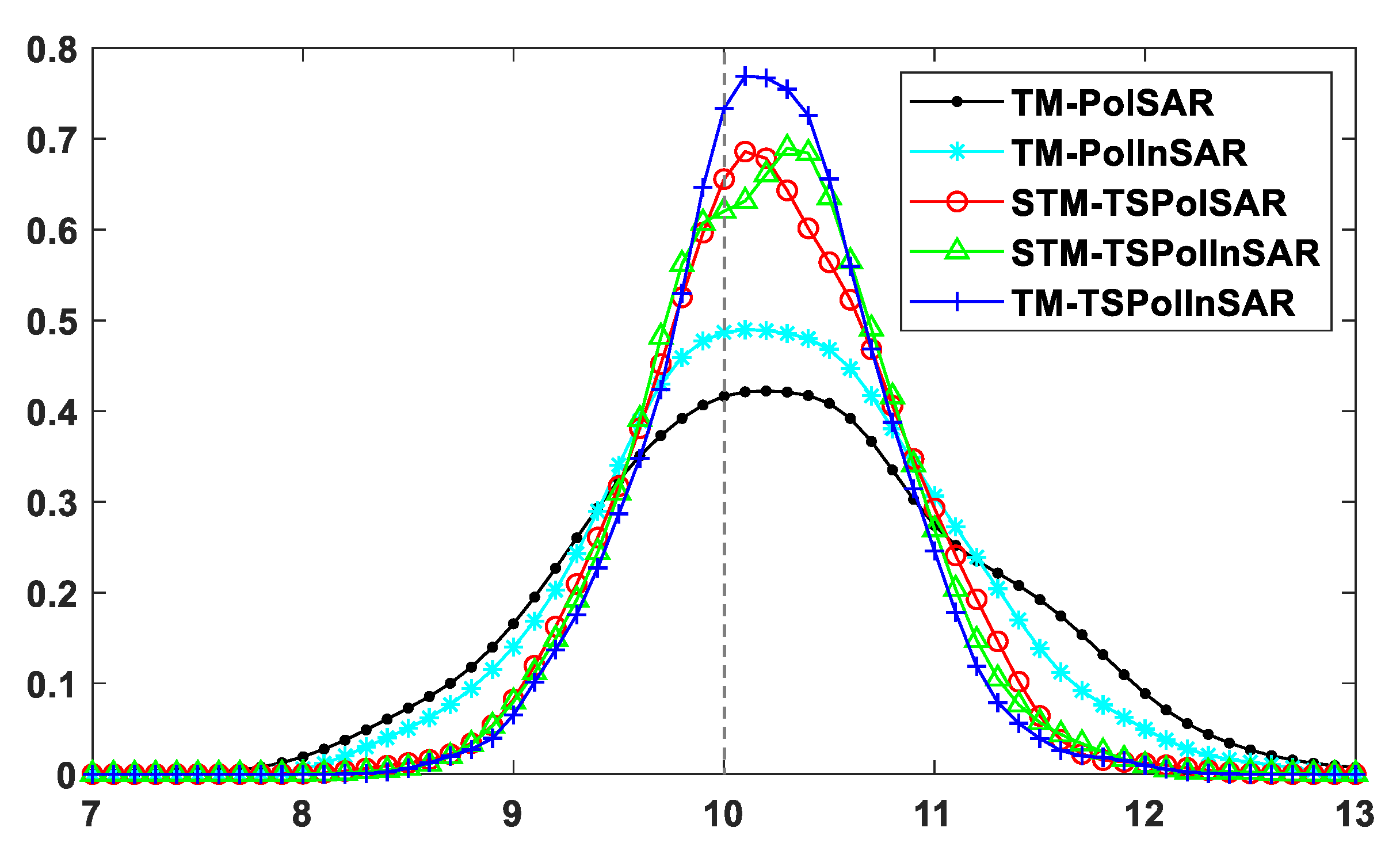

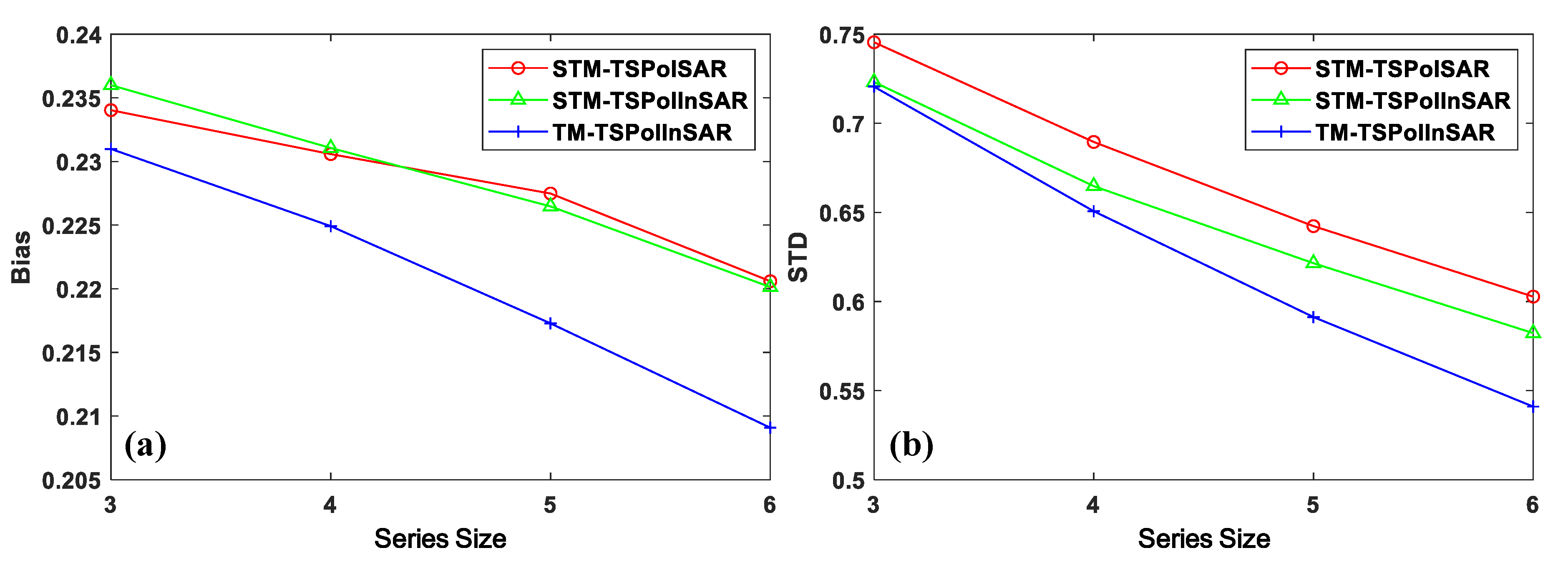
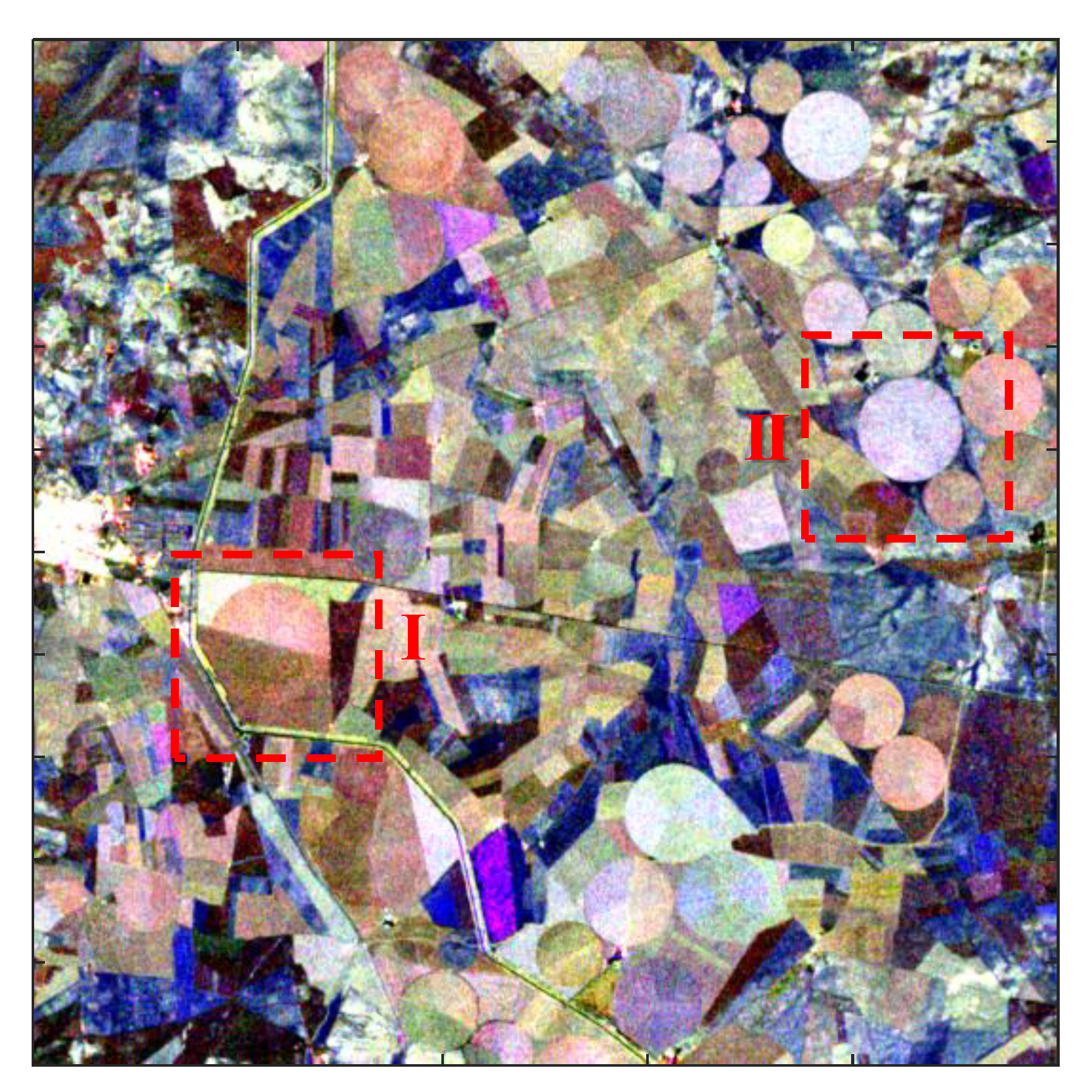

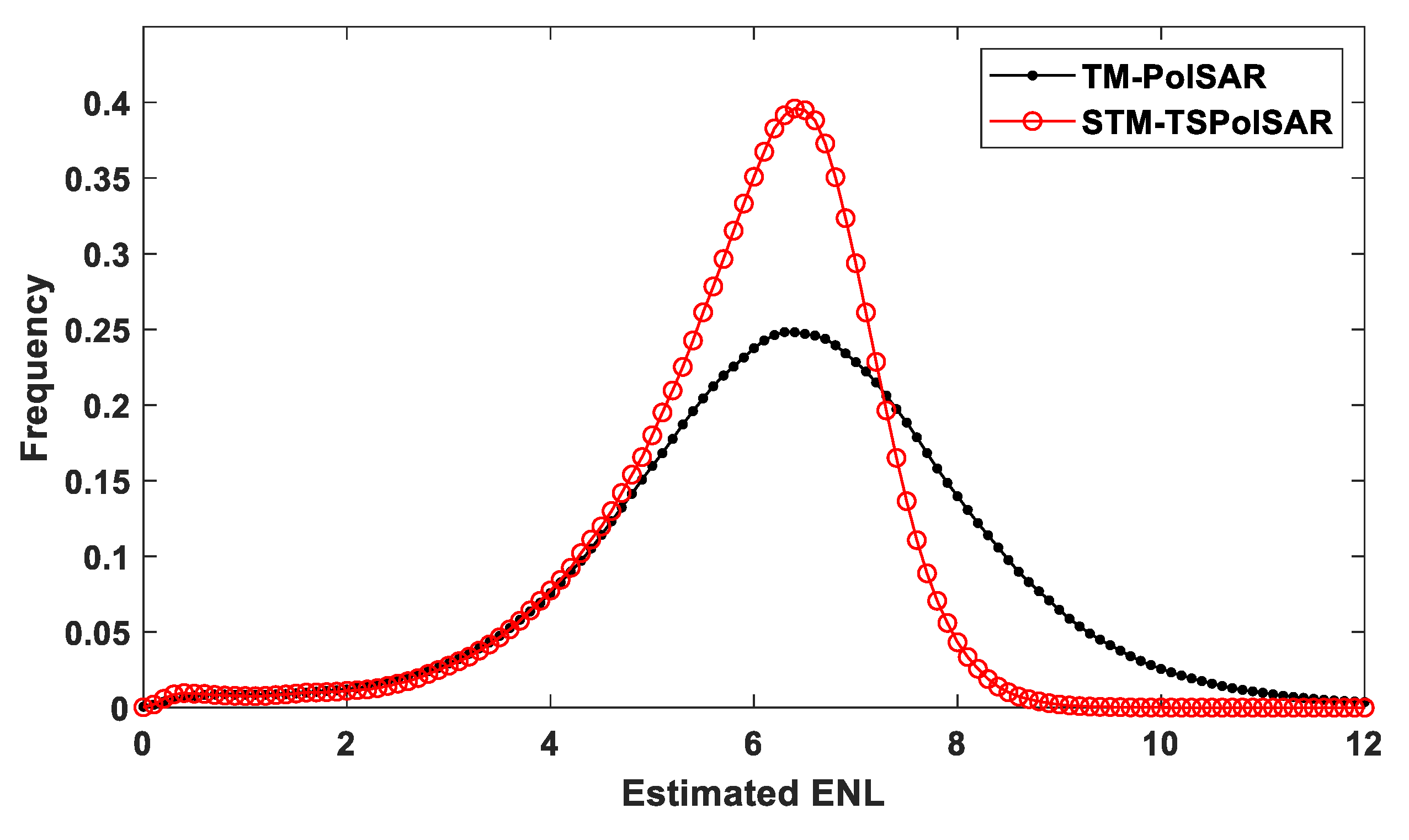
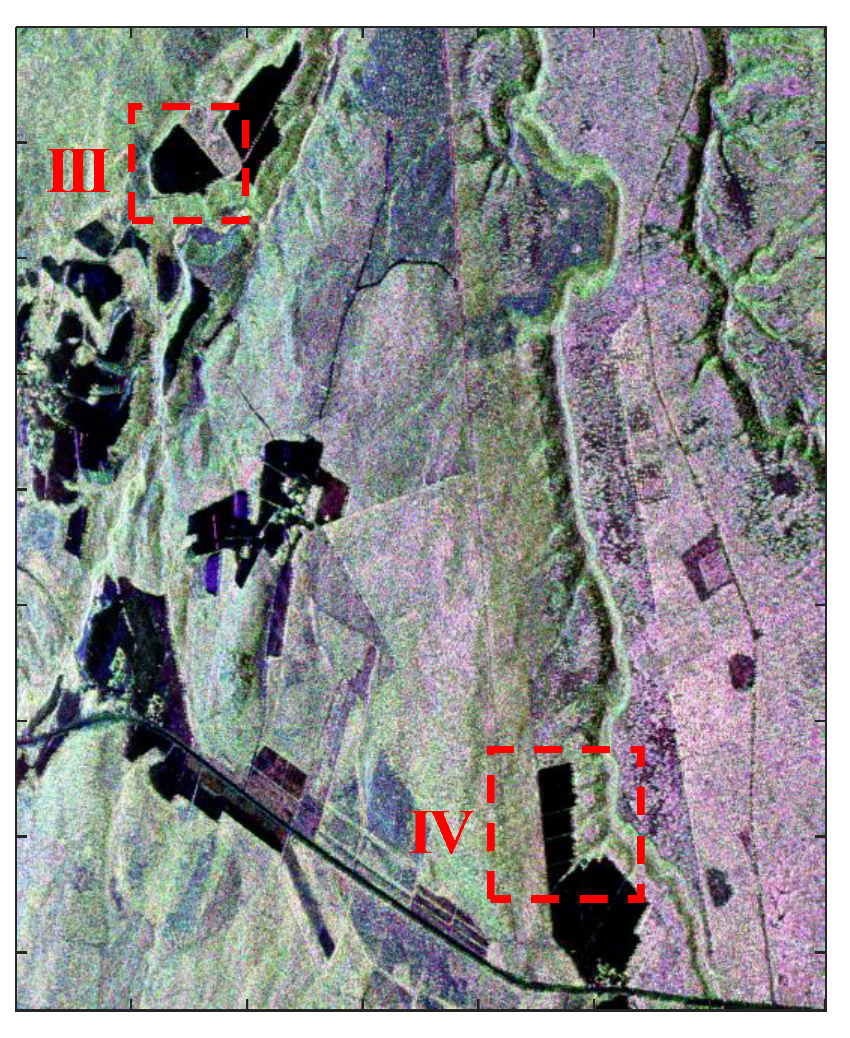
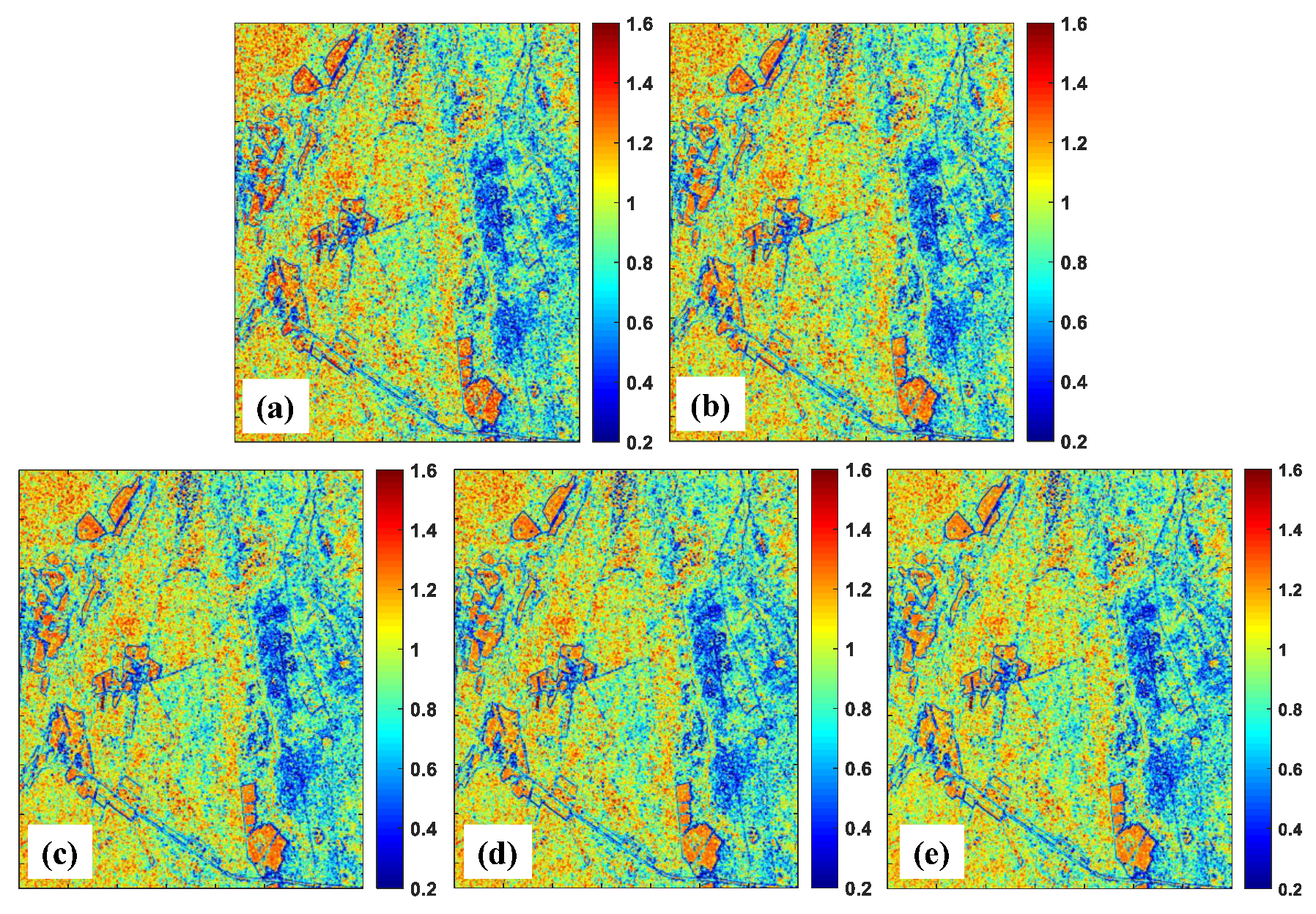
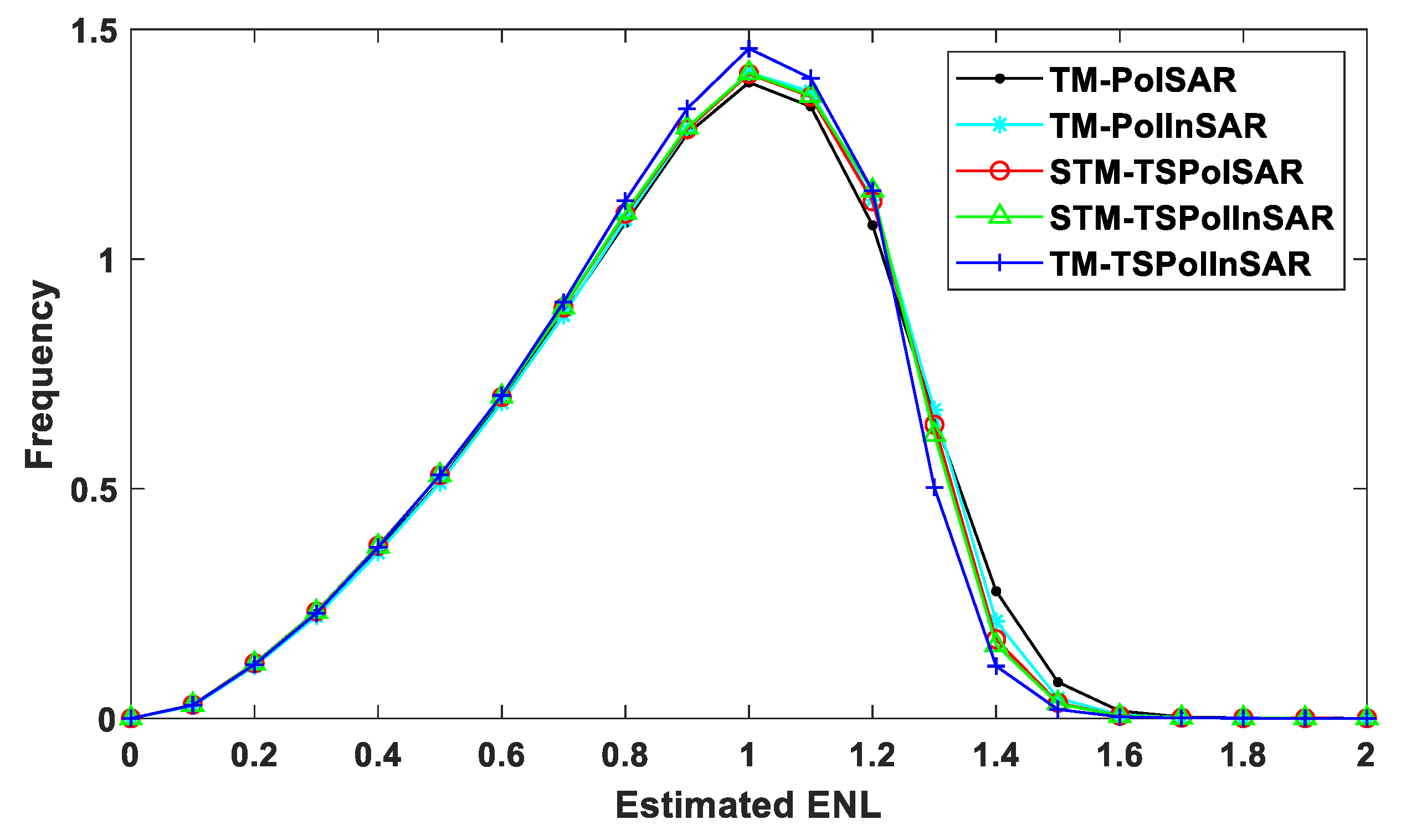


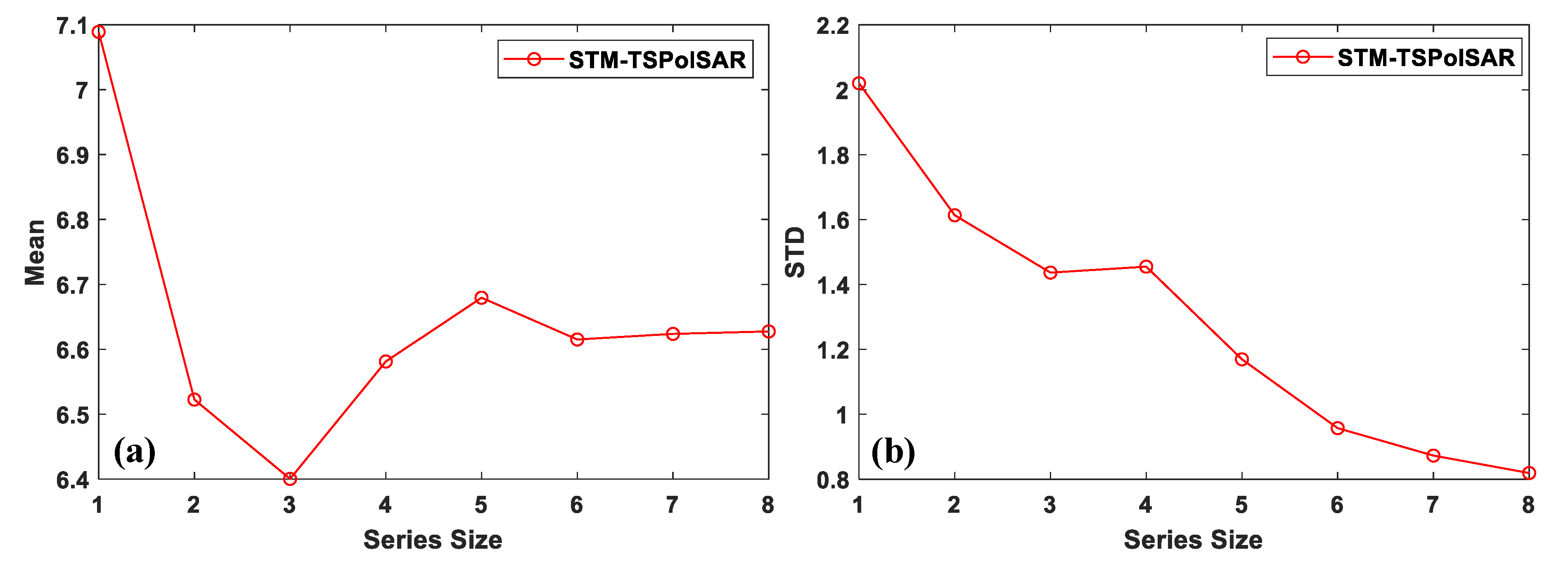
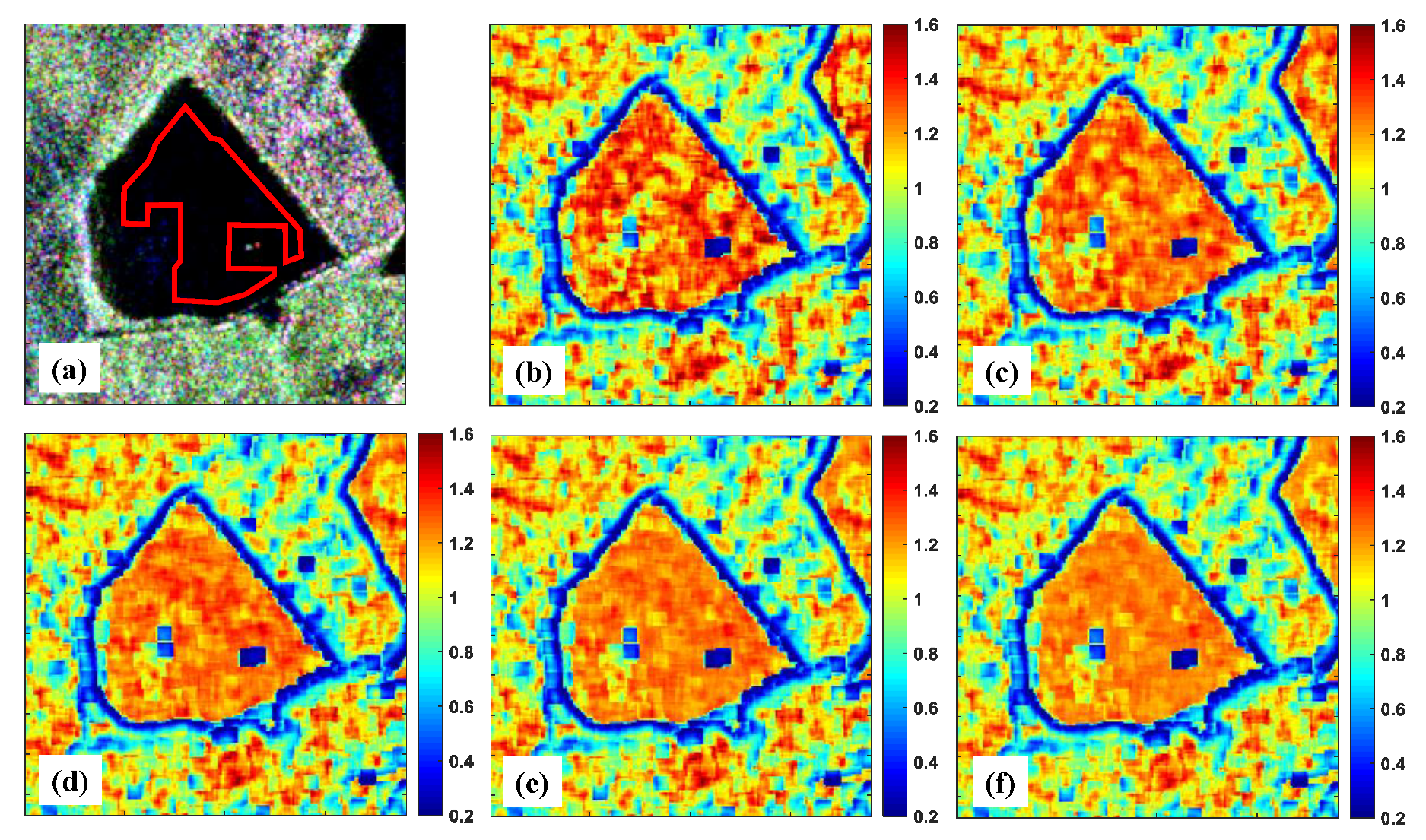

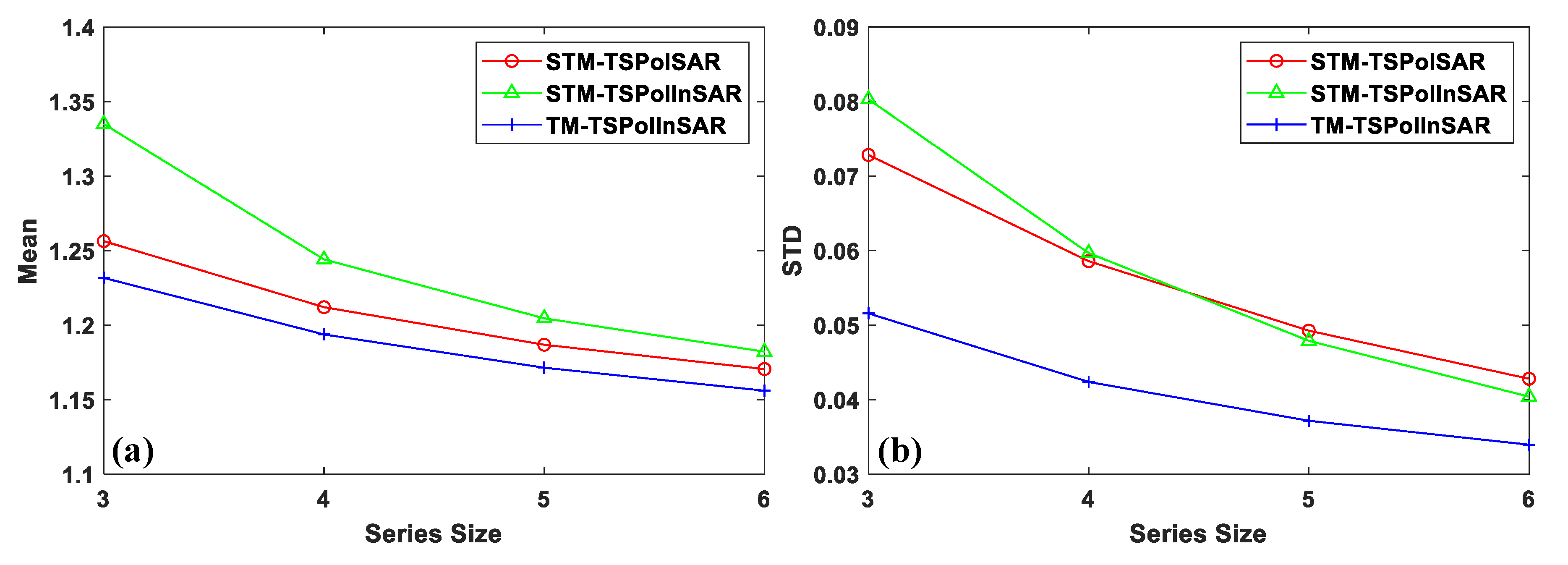

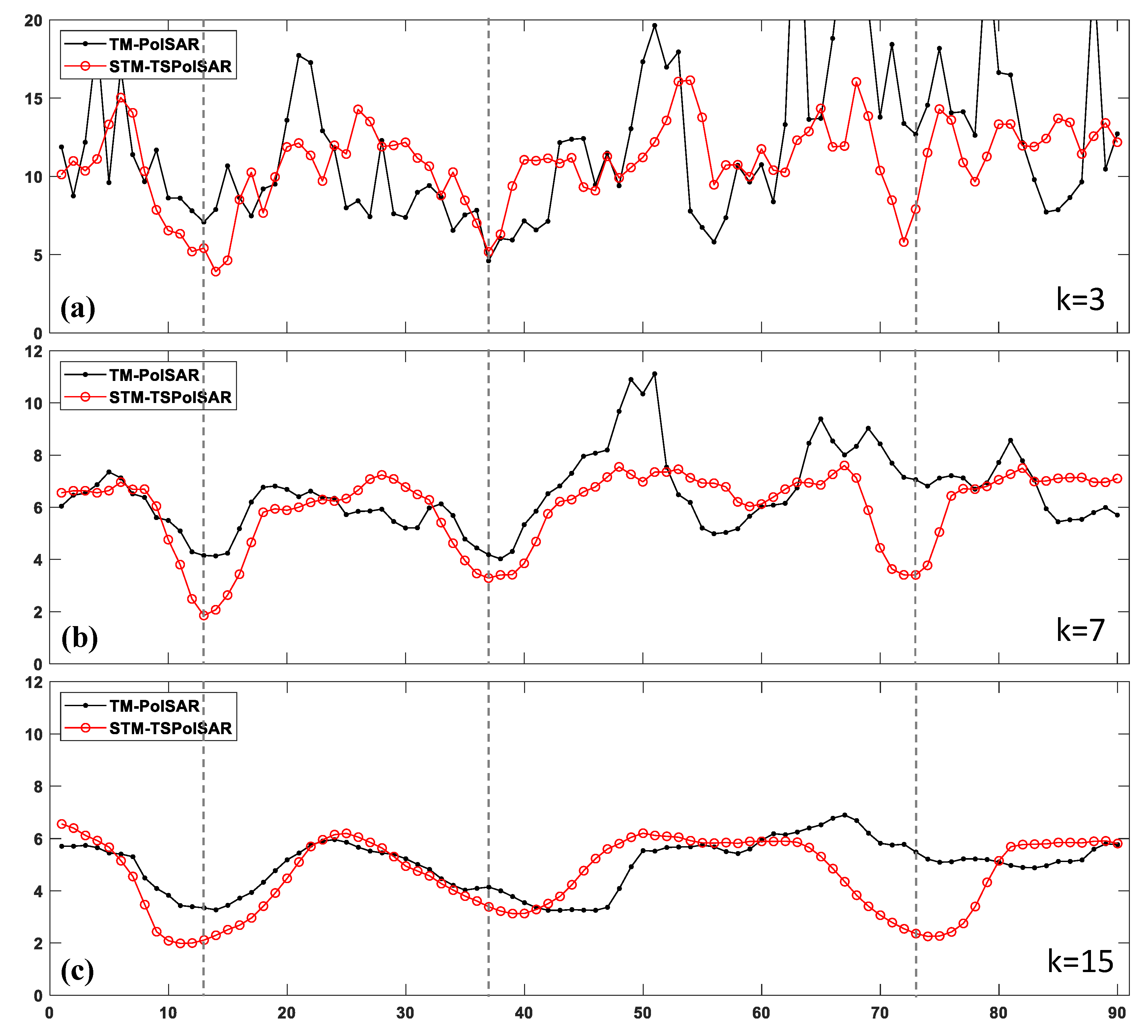
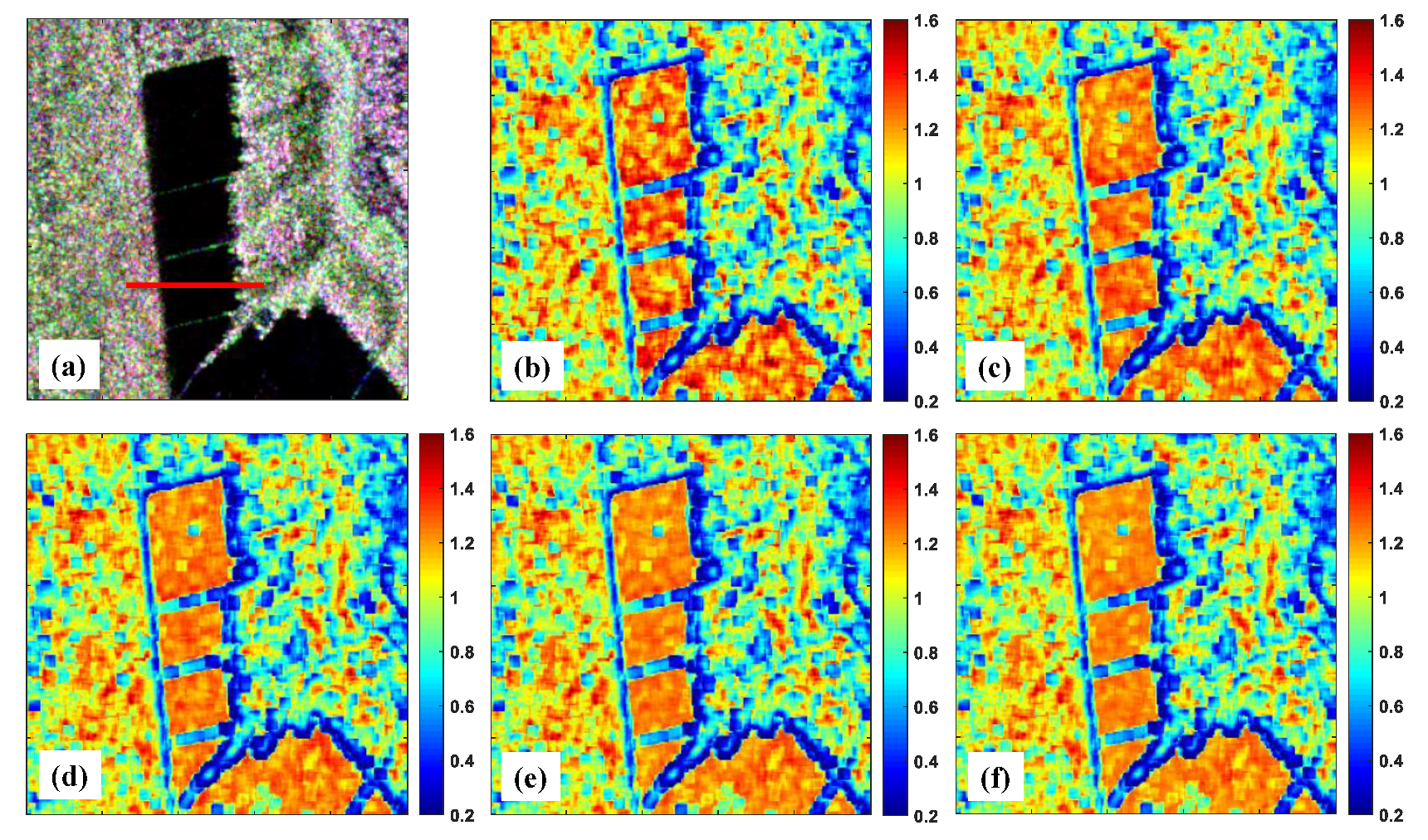


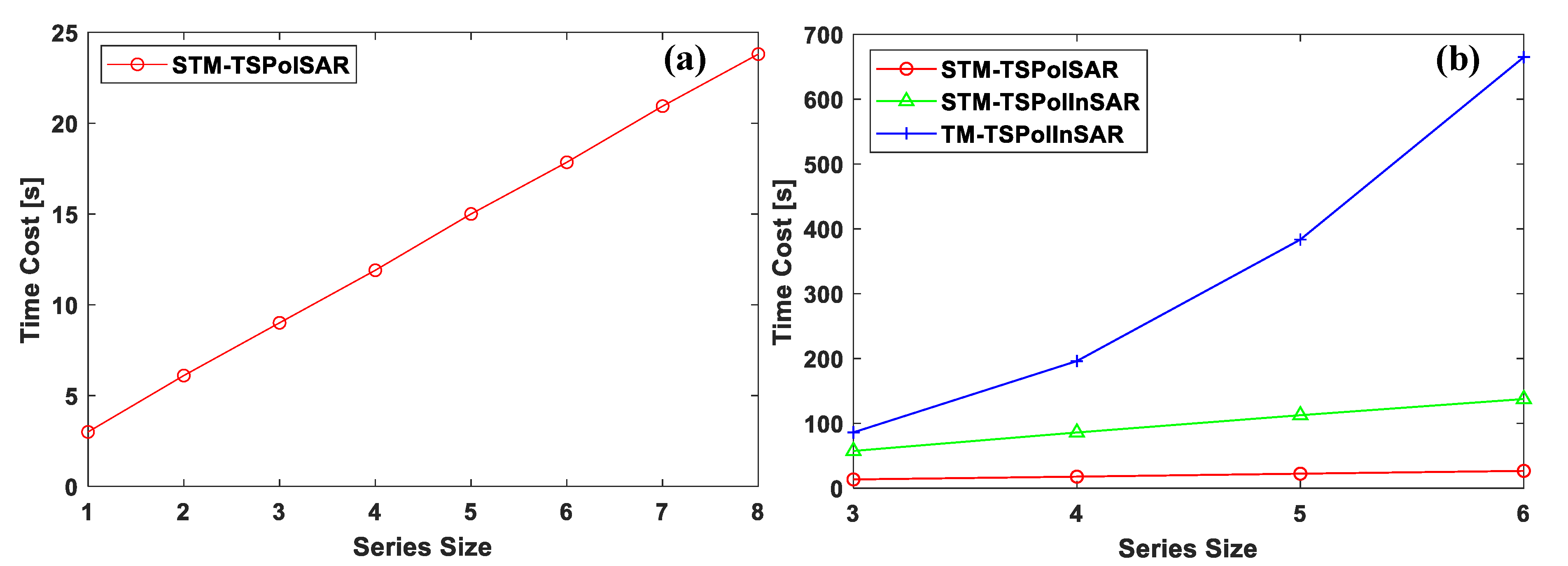
| Estimator | TM-PolSAR | TM-PolInSAR | STM-TSPolSAR | STM-TSPolInSAR | TM-TSPolInSAR |
|---|---|---|---|---|---|
| Memory Size | IJP2 | IJ(2P)2 | IJP2N | IJ(2P)2(N−1) | IJ(PN)2 |
© 2020 by the authors. Licensee MDPI, Basel, Switzerland. This article is an open access article distributed under the terms and conditions of the Creative Commons Attribution (CC BY) license (http://creativecommons.org/licenses/by/4.0/).
Share and Cite
Shen, P.; Wang, C.; Fu, H.; Zhu, J.; Hu, J. Estimation of Equivalent Number of Looks in Time-Series Pol(In)SAR Data. Remote Sens. 2020, 12, 2715. https://doi.org/10.3390/rs12172715
Shen P, Wang C, Fu H, Zhu J, Hu J. Estimation of Equivalent Number of Looks in Time-Series Pol(In)SAR Data. Remote Sensing. 2020; 12(17):2715. https://doi.org/10.3390/rs12172715
Chicago/Turabian StyleShen, Peng, Changcheng Wang, Haiqiang Fu, Jianjun Zhu, and Jun Hu. 2020. "Estimation of Equivalent Number of Looks in Time-Series Pol(In)SAR Data" Remote Sensing 12, no. 17: 2715. https://doi.org/10.3390/rs12172715






